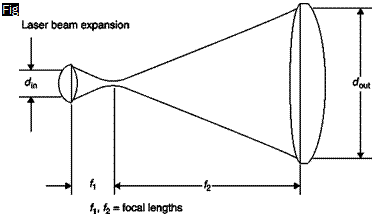Laser sources for the optical methods of visualization
For the high degree of coherence, the laser appears an attractive light source for optical methods of visualization, especially for the interferometric methods, some of which can only be achieved if a laser is used as the light source.
To use a laser as a light source in flow visualization, it is necessary to provide two optical components. The first is an objective of very small focal length, 1 cm or less, which makes the thin and parallel laser beam divergent. The focus of this lens coincides with that of a subsequent larger diameter lens through which the beam is made parallel before traveling through the test chamber. The set of two lenses is the beam expander (Figure 4.7).
 |
The second element is the pinhole that is necessary to clean the beam from the background noise of diffraction. Because of its high level of coherence, the laser light generates a significant configuration of diffraction images of rigid bodies and edges so that the cross-section of the beam is not evenly illuminated but disturbed by various fringes and interference patterns that can also generate diffraction of light on particles of dust on optical surfaces. Also, if there are higher-order transverse modes, the distribution of light in the focal plane of the beam expander is not a single bright spot but rather a pattern of diffraction usually in the form of some concentric circles of light and dark alternately. The diameter of the pinhole, which is placed in the focus of the beam expander, must
be so small as to let pass only the light of the inner circle, the image of zero-order diffraction; in this case, the cross-section of the beam becomes evenly illuminated. The pinhole and the beam expander form a spatial filter.














